


Let us begin with one of Youssef Chahine’s zaniest musical sequences, occurring twenty-five minutes into Silence … on tourne (2001). It begins with Lamey (Ahmed Wafik), a Nicolas Cage look-alike and “boss of the quarter”, smoothly escaping from a film set and then strutting through an underground métro train station – which seems to be just another part of the set. Fans and assistants flock around him. Then a train arrives, a visible camera crew tracks into its door and our attention passes across to the noticeably older woman who emerges, Malak (Tunisian singing star Latifa). She is besotted with the vain, elusive young man, and sings of her feelings for him.
Artifice and reality are already completely confused here: like her prey, is she part of a film, or escaping from it? She looks everywhere for her beloved – like in the crowded train station of Hitchcock’s North by Northwest (1959), she turns around a guy who is identical to him from the back and is comically disappointed by the reality she discovers – and is further taunted by a serial line of also identical male tango-dancers bathed in red light, which evokes a memory of Jane Russell amid the indifferent muscle-men in Hawks’ Gentlemen Prefer Blondes (1953). Then it’s back to the cool cad, accompanied by a dancing ‘street gang’ that resembles Michael Jackson’s backing troupe in the famous videos for Thriller or Bad.
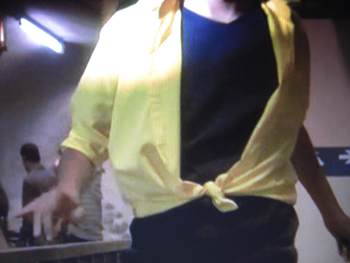 After a few exterior street shots – she forever pursuing the indifferent man and serenading him – we enter a cellar bar; in fact, it is the ‘real’ film set where, in a previous sequence, we saw the shooting of a scene featuring Malak. She now has a dream-vision (as her song becomes ‘voice-off’) of dancing, in historical costume, with him; for a few moments, this segues into a black-and-white quotation from an old movie, a memory perhaps of Lubitsch’s The Merry Widow (1934) or, more likely, the lavish musical that Chahine cites as a major influence in his youth, Julien Duvivier’s The Great Waltz (1938). (1) But brought back to the present, Malak grasps the reversal of their positions: he is the star, and she is the pining ‘extra’ (something we will see occur in reality, during a concert sequence later in the film, when Lamey will sing the same “Takeaway” song).
After a few exterior street shots – she forever pursuing the indifferent man and serenading him – we enter a cellar bar; in fact, it is the ‘real’ film set where, in a previous sequence, we saw the shooting of a scene featuring Malak. She now has a dream-vision (as her song becomes ‘voice-off’) of dancing, in historical costume, with him; for a few moments, this segues into a black-and-white quotation from an old movie, a memory perhaps of Lubitsch’s The Merry Widow (1934) or, more likely, the lavish musical that Chahine cites as a major influence in his youth, Julien Duvivier’s The Great Waltz (1938). (1) But brought back to the present, Malak grasps the reversal of their positions: he is the star, and she is the pining ‘extra’ (something we will see occur in reality, during a concert sequence later in the film, when Lamey will sing the same “Takeaway” song).
Finally, we are transported again to a huge ship full of passengers (and a line of percussionists), where Malak is beseeching, from a distance, Lamey – who is flirting with a woman he picked up in the tavern – and also cursing him with her eternal presence in his heart: Chahine dissolves, several times over, on the repeated gesture of Malak pointing at him accusingly.
Of course – the viewer knew it from the start – the whole scene is a fantasy, the daydream of the younger man who hopes to seduce and exploit the older star for the sake of his career. It reprises elements from earlier in the film and anticipates much that is to come later: an almost Ophulsian structure of echoes and prefigurations How many such fantasy musical sequences recur in Chahine’s work! In fact, and most importantly, even the scenes which are not explicitly marked as nocturnal dreams or daytime reveries have a pronounced quality of projection: they almost always concern people who long to enter the magical space of a certain experience.
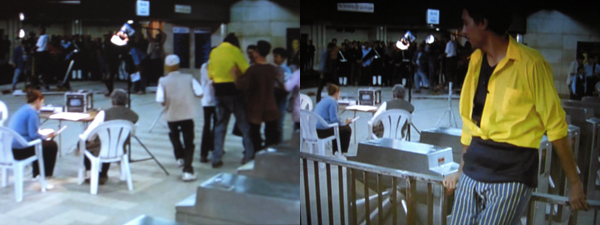
Chahine is not a filmmaker who likes musical soliloquies, Minnelli-style: rather, it is always a large-group experience, a rich profusion of bodies, colours, forms, overlapping trajectories. The more dancers he can pack into an overhead crane shot, the better he likes it. And, like Jerry Lewis in the ‘60s, Chahine loves to include, as part of this ‘magical mystery tour’, the paraphernalia of filmmaking itself: the set, the cameras, the lights. (2) Even the landscape vistas of his historical films frequently look like imitation Hollywood (or Bollywood) sets about to ignite into a musical number. The more baroque, crowded and multi-layered the space of the fantasy, the greater a character’s yearning to enter it, fuse with it.
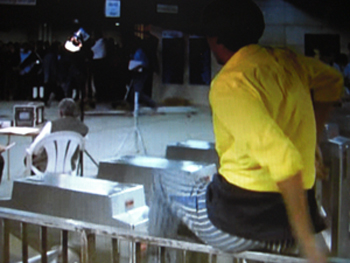
In Alexandria … New York (2004) – a film co-dedicated to the celebrated Palestinian-American political-cultural commentator Edward Saïd – Yehia (Mahmoud Hemeida), the evident alter ego of Chahine, states the ‘official line’ on what the filmmaker’s work is essentially about: “Is the Other relevant to our lives or not?” True enough. But aren’t Chahine’s films even more powerfully about a certain fantasy of the self – precisely the self as Other, as the person excluded from the scene of the song, the dance, or the ritual celebrations of erotic romance, such as a wedding?
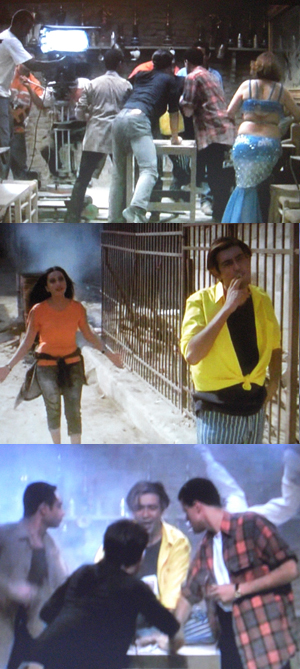

This is not a solipsistic fantasy – although it can certainly be proudly narcissistic, as in the arc of life-achievements in Alexandria … New York that take Yehia from the applauding ‘standing ovation’ crowd at his American college graduation (summa cum laude, the highest marks ever!) to the tribute paid to him (or rather, in documentary video footage, Chahine himself) at the Cannes Film Festival in 1997 … With, in-between, a loss of his virginity that, as he jokes, “made Egypt proud – I made the whole Arab world proud!”

Unquestionably, the figure of the self in Chahine’s films wants to be recognised, and even adored – adored by a teeming multitude. But the urge to belong to a community, to enter into its physically expressed joy, is a fully political drive in the cinema of Chahine. World politics, ‘big picture’ politics, is (as Bérénice Reynaud has rightly remarked) always also and simultaneously a politics of desire. (3) Hence the emotion – emotion of a profoundly melodramatic magnitude – that attaches itself to these all-important moments of yearning, acceptance and recognition. And hence, as well, the angry, sometimes violent bitterness that can flow from acts of rejection and exclusion, when the Other is reminded that he precisely the Other.
It is this overall political attitude – the heartbroken stance of the excluded – which feeds back into the smallest and most charming details of Chahine’s extravagant musical scenography and choreography. Quite simply, there is a ‘corner’ for everyone in his musical sequences, a place and a role, no matter how fleeting or surreal. And this attention to a ‘democratic’ choreography is a true and inspired mutation in the international genre of the musical, an alteration (or even perversion) of the norm that takes us far from the MGM era of ‘golden Hollywood’ – where the split between foreground star and background extras is always rigorously policed and built into the aesthetic plan.
Let us consider some musical sequences both fantasised and real in his work. In Alexandria … New York, the hero, in his youthful American college days, tries to persuade a vendor on the street to give him food, by asking her to ‘imagine’ an elaborate dance sequence of his invention: a version of Carmen (he has previously been an observer on the set of Charles Vidor’s The Loves of Carmen [1948] starring Rita Hayworth). Yehia may simply be dancing alone in the night street, but Chahine immediately launches, Busby Berkeley-style, into his inner vision of a studio-staged extravaganza. In a tiny, fleeting but highly significant moment of this sequence, Yehia sweeps up a line of spectators, one by one, into his dance moves: one of these spectators happens to be the vendor, still in her street clothes, and she seems as surprised as we are to see her here!
 The musical fantasy has thus generously ‘incorporated’ even the most banal and unglamorous details of the everyday world from which it springs – a beautiful illustration of the ‘utopian impulse’ of the musical genre theorised in the mid 1970s by Richard Dyer, and given a very dark, dystopian twist in Tsai Ming-liang’s musical interludes in The Hole (1998) and The Wayward Cloud (2005), or in Lars von Trier’s Dancer in the Dark (2000). (4)
The musical fantasy has thus generously ‘incorporated’ even the most banal and unglamorous details of the everyday world from which it springs – a beautiful illustration of the ‘utopian impulse’ of the musical genre theorised in the mid 1970s by Richard Dyer, and given a very dark, dystopian twist in Tsai Ming-liang’s musical interludes in The Hole (1998) and The Wayward Cloud (2005), or in Lars von Trier’s Dancer in the Dark (2000). (4)
In every Chahine musical sequence, the on-screen spectator – of course, the imaginary delegate of all we off-screen spectators – has a special part to play, a small but touching ‘starring moment’. In Destiny (1997), there is a spectacular bit of business involving the choreographic hurling of chairs during a dance sequence. In the midst of it, there is a puzzling detail: two secondary characters expertly fall to the floor in an expectant posture. Soon enough, we realise that they are there for: to catch the chairs! Any similar sequence in Hollywood would have simply had the chairs disappear in mid-air off-screen, to be collected by invisible stage-hands. But not in Chahine.
Chahine honed an aesthetic of propulsion – propelling characters into action, movement, and especially the dream-space of their fantasies, ideals or goals. Remember our opening example: from a métro to the street to a cellar-bar to a ship, covering at breathtaking speed a seamless montage of at least three different songs! A particular technique he used to clinch this effect is evident everywhere in his work: Chahine liked to ‘cut out’ of a scene – any scene – very quickly, often abruptly or disconcertingly, before the final moment of pause, rest or ‘absorption’ characteristic of much screen drama. This is what the artist-scholar Louis Giannetti calls the device of ‘cutting before the content curve peaks’ in a scene. (5) Chahine uses this technique whether he is making a contemporary comedy, or a historical pageant; sometimes it makes his films seem giddily like extended trailers. Often the device creates deliberate effects of confusion or disorientation: one character appears to be answering the previous remark by another character, but they are in fact in two completely different times and places! (Chahine was undoubtedly inspired in this by Welles’ similar experiments with propulsive editing in Citizen Kane.)
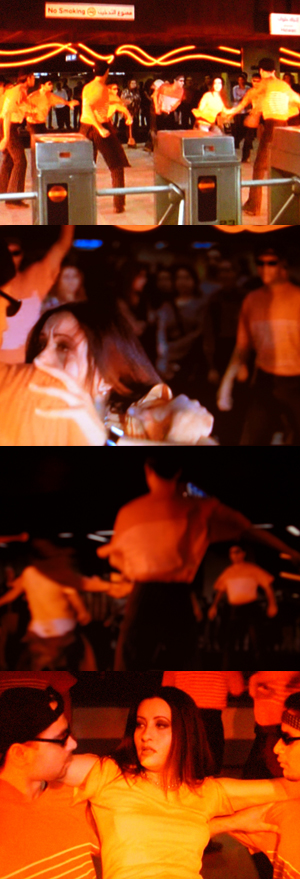
Few films begin with a musical sequence as exhilarating as that which kicks off Silence … on tourne. This elaborately filmed concert expresses Chahine’s love of ‘show biz’ tradition and mythology at every level and every moment – from the first sounds of the large orchestra tuning-up under the credits, and the first images of audience members arriving and taking their seats. Of course, with this prologue, Chahine does not miss the opportunity to swiftly introduce half a dozen of the story’s central characters.
Malak sweeps in from the back of the theatre, inviting the audience to fill in words of the song - with its dynamic swells of volume and shifts in tempo – and serenading select audience members. The spotlight, literally, is not only for her but for everyone she solicits: her pianist, the orchestra conductor, spectators … The song itself – in a mode well known in France, but less so in the English-speaking world – is an anthemic ode to the great stars of a nation’s popular music, whose images are projected large at the back of the stage. The song quickly becomes a patriotic, even a religious declaration: “You are truly an Egyptian!”
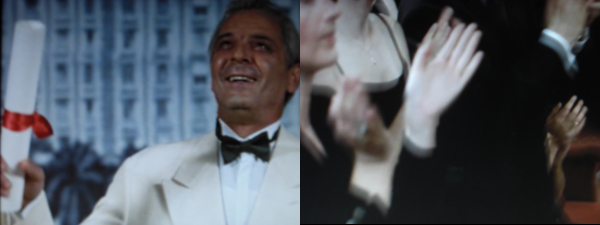
All the while, Chahine’s special gift for integrating a lyrical mise en scène with a tight découpage proclaims itself: the camera swings, lifts, tracks and pans, but the individual shots are joined by a hundred clever ‘touches’ and inventions, like background singers pointing to cue a cut, or Malak entering or exiting the frame. Projected on a big, loud screen – which is how I first saw the film at the Rotterdam Film Festival in 2001 – the scene is not only euphoric, but also immediately creates what American cultural analysts call ‘audience-product bonding’: the real audience sees itself mirrored in the ecstatic on-screen audience, and we, too, become part of the show, part of the rapturous community evoked and produced by the song.
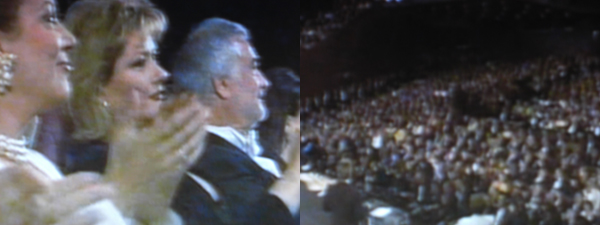
But what is it exactly to ‘truly be an Egyptian’, or an Arab, in the universe of Chahine? All his films are about what is called in America ‘identity politics’, and a sense of personal identity is always a question of identification – the feeling of belonging to a group, a community. Identity is not what one is born with – it is not only, or ultimately, a question or race or blood – but what one becomes, in a dynamic process of relation, incorporation, projection. Think, for instance, of the family unit in Chahine: there are few filmmakers (apart from another lively melodramatist, Pedro Almodóvar) for whom the family is such an open, extended unit, embracing distant relatives, friends, work colleagues, ex-spouses and old lovers from the distant past …
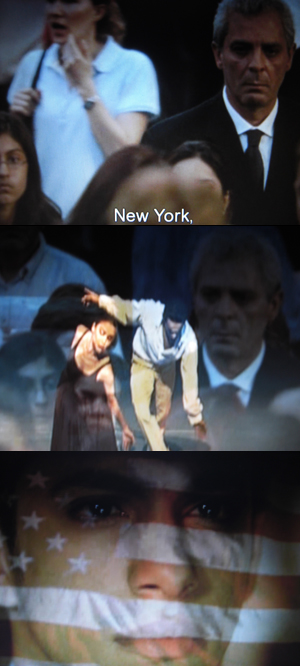 Indeed, wouldn’t Chahine’s image or metaphor of the ‘ideal family’ be the gregarious, heterogeneous team assembled for a film shoot, constantly overflowing the set and spilling into real life with its interpersonal delights, intrigues and complications? Not a biological family, but a show biz family? And – with very little ambience of perversity or transgression – a highly eroticised, polymorphously perverse, happily functioning family: look at how calmly accepting Yehia’s wife (in Alexandria … New York) is, not only of her husband’s life-long obsession with his youthful first love, but the unknown adult son, resulting from that fleeting union, who now enters their life! “I want him”, she murmurs as he watches this beautiful young man dance ballet on stage, maternal or paternal feelings – as always in Chahine – not terribly far from libidinal attachments and investments.
Indeed, wouldn’t Chahine’s image or metaphor of the ‘ideal family’ be the gregarious, heterogeneous team assembled for a film shoot, constantly overflowing the set and spilling into real life with its interpersonal delights, intrigues and complications? Not a biological family, but a show biz family? And – with very little ambience of perversity or transgression – a highly eroticised, polymorphously perverse, happily functioning family: look at how calmly accepting Yehia’s wife (in Alexandria … New York) is, not only of her husband’s life-long obsession with his youthful first love, but the unknown adult son, resulting from that fleeting union, who now enters their life! “I want him”, she murmurs as he watches this beautiful young man dance ballet on stage, maternal or paternal feelings – as always in Chahine – not terribly far from libidinal attachments and investments.
But this is not the traumatic trace of any abiding Oedipus or Electra complex: it is the mark of an all-inclusive desire that never abates in its strength, even when youth is a long-past, nostalgic, romanticised memory: a single look (like that exchanged between Malak and Lamey at the end of the opening song in Silence … on tourne) is spark enough to set desire, with all its yearnings and promptings, racing again.
Destiny is among Chahine’s most developed musings on the necessary heterogeneity of a healthy, functioning, politically compassionate and inclusive identity politics. The Arab identity as represented by the philosophical teachings – and also the lifestyle – of Averroës is multi-ethnic, multi-cultural, polysexual, simultaneously rational and mystical. The film is a history lesson and allegory pointedly addressed to the rise of Muslim fundamentalism in the present-day world – as Chahine’s cry, written on screen over the final flames, makes clear: “Ideas have wings, no one can stop their flight!”
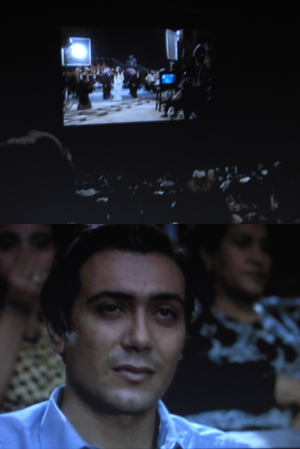
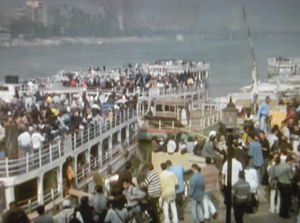
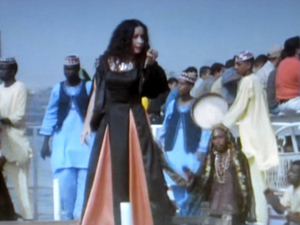
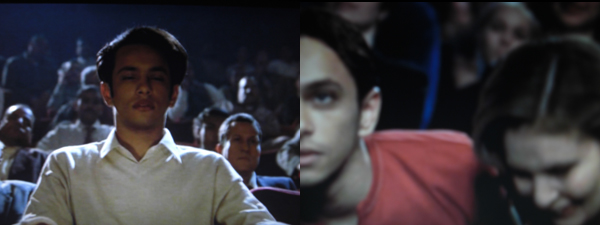
The political message is, one level, simple and obvious enough. But it is the filmmaker’s way of embodying it cinematically which is unique, powerful and persuasive: precisely in musical sequences. The marvellous communal singing and dancing in the Averroës family encampment is (as Malek Khouri has pointed out) an amazing, historic hybrid of inputs and influences: “Arab, Spanish, gypsy, flamenco, old and contemporary formats”. (6)
The one aspect of the hybrid identity that Chahine projected which frayed – and frayed badly – in the final decade of his life was the link to America. Or, more specifically, the brutal décalage, which upset and infuriated him so deeply, between the imaginary America of yesteryear that came through his absorption in the Old Hollywood dream, and the real America that (in his view) supported Israel against Palestine, and aided in committing unspeakable atrocities in the name of this support. Adding to that, as we see in Alexandria … New York, was an accumulating sense of personal and professional rejection: his films were continually denied American theatrical distribution. What a violent disenchantment with the American Dream, way beyond what someone like Wim Wenders has ever suffered!
The controversy that Chahine stirred in his public persona around the ‘American question’, especially in the aftermath of the Twin Towers attack – a controversy re-created and dramatised in his episode of 11’09’’01 – September 11 (2002) – is well-known and much-debated. Chahine’s invocations of democracy took a bitter turn: if the citizens of the democratic American State elected their leader Bush, they are all responsible for the evil that followed; this is spelt out both in September 11 and Alexandria … New York.

But how does all this figure in his films? Revenge is sweet in Alexandria … New York where all the scenes set in America are – in a wicked reversal of Hollywood’s imperialist linguistic convention – spoken in Arabic; and the final, expected reunion between father is son is suspended, as both men pace, alone and unreconciled, in the New York streets. But even more poignant is the reversal effected in his September 11 sketch, where the digital trickery that was used in a such a joyous, cartoonish, Tashlinesque spirit (bodies spinning, eyes popping, umbrellas floating) in Silence … on tourne now expresses a grave and utopian spirit: a crane shot travelling up the length of the World Trade Center is digitally conjured, the ghosts of both Palestinian and American soldiers materialise and vanish, and a click of the director’s computer reverses the fatal tragedy of the towers. Even amidst all the death, mourning, despair and hatred, Chahine’s ‘magic wish’ reappears.
There must be literally hundreds of reviews and articles on Chahine – especially outside of Egypt and the Arab world at large – that remark, in puzzled, sometimes disapproving tones, on the ‘odd mixture’ of elements and genres in his work: comedy, melodrama, sentiment, politics, show biz, nostalgia, history, cultural reflection, Old Hollywood cliché. It’s the kind of ‘mash-up’ which André Téchiné once jokingly referred to (in another context) as a méli-mélo, an all-mixed-up melodrama. Is there something in Chahine’s vision of this pile-up that does not ‘translate’ well to other countries and cultural contexts – or is the problem ours, as unwilling or defensive spectators?
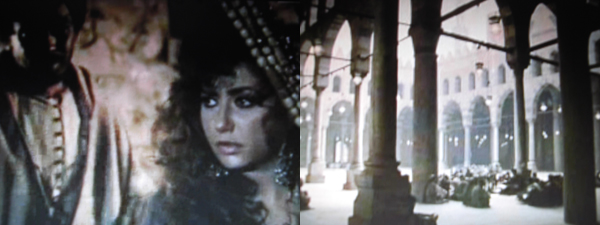
There is a deliberate, obstinate naïvete that Chahine proudly adheres to, as part of his allegiance to popular culture in its many forms: the music always rises, the lighting changes to intense blue and red at moments of confrontation or death, the tears always flow, believers make grand, didactic declarations of their principles, lovers or family members who embrace in a reunion always spin around in a circle, while frequently the camera joins them in this wild but perfectly choreographed movement …
Although there is every kind of humour (parody, satire, burlesque, sarcasm) in Chahine, there is none of that laughter which puts up a superior or condescending distance between ourselves and what is presented on screen: although we are eternally aware of the vibrant artifice, and the extraordinary effort taken to produce every frame, paradoxically we are invited to project ourselves into the emotional event on-screen even more completely. To be a member of the wedding (as in the title of Carson McCullers’ novel), a participant observer, a film-lover compelled – even if only within our minds – to sing and dance, too. For Youssef Chahine has prepared a space, a place for us all in the generous circle of his spectacle.
(Spanish translation, by Óscar Brox)
 |
(1) See Ibrahim Fawal, Youssef Chahine (London: British Film Institute, 2001).
(2) See Chris Fujiwara, Jerry Lewis (Illinois University Press, 2009).
(3) Bérénice Reynaud, “Everywhere Desire”, Sight and Sound (August 1997), pp 20-23.
(4) See my “Musical Mutations: Before, Beyond and Against Hollywood”, in Jonathan Rosenbaum and Adrian Martin (eds.), Movie Mutations: The Changing Face of World Cinephilia (London: British Film Institute, 2003).
(5) Louis Giannetti, Understanding Movies (New York: Prentice Hall, 2004).
(6) Malek Khouri, “Anxieties of Fundamentalism and the Dynamics of Modernist Resistance: Youssef Chahine’s Al Maseer”, Cineaction (Canada), no. 69 (June 2006). On-line at <http://cineaction.ca/issue69sample.htm>.
